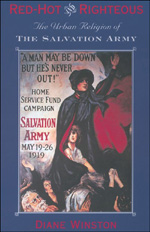 (Reprinted with permission from the Wall Street Journal, written by Fred Barnes.)
(Reprinted with permission from the Wall Street Journal, written by Fred Barnes.)
Its blue-uniformed soldiers still appear at shopping areas at Christmas, jingling bells to collect donations in a kettle. But the Salvation Army isn’t what it used to be. In 1887, the army held 100,000 street meetings in cities across America, noisy affairs with bands and preaching and pretty young women in bonnets, all designed to win souls for Jesus Christ. (For the Broadway version, see Guys and Dolls.) In 1998, it held only 2,900 of them.
And yet, while less visible now, the Salvation Army has grown into America’s largest charity, focused on disaster relief, camps for underprivileged kids, the treatment of alcoholics, and shelter for the poor. In fact, measured by the amount of aid actually given to suffering people rather than eaten up in salaries and administrative costs, the Salvation Army is probably the country’s most effective charity as well. Annual budget: $1.7 billion.
The Salvation Army’s transformation has also made it an object lesson, especially now that politicians—notably Al Gore and George W. Bush—propose to enlist “faith-based organizations” in the duties of the welfare state. So far, faith-based social welfare projects have done admirably well. But there’s a rub. The religious groups that operate them face the prospect of being distracted from the job that’s presumably most dear to them, proselytizing the unsaved.
That is what brought the Salvation Army to America in full force in 1880. Founded in Britain by a street preacher named William Booth, the army drew on a variety of trends in evangelical Christianity, particularly the revivalism that spread across the north of England in the eighteenth and early nineteenth centuries. Booth added a new element, attention-getting tactics to pull in the faithless. Salvationists played music, sang, danced, and put on shows, and also wore uniforms and carried military titles. “They realized the need to communicate more than just a message of personal salvation,” writes Diane Winston in Red-Hot and Righteous, which colorfully chronicles the army’s efforts in New York
until 1950.
The Salvation Army was an urban movement, and it quickly struck roots in cities all over America. It had its greatest success in winning converts in Chicago, according to Edward McKinley’s definitive history of the army in the U.S., Marching to Glory, published in 1980. But the headquarters remained in New York, and some of the army’s most elaborate theatrical pageants were staged there.
For two decades or more, Salvationists were viewed as wild and undignified, and they were frowned upon by Christians in more mainline denominations. But their image gradually improved as their programs for the needy took hold. When young Salvation Army women, nicknamed Sallies, went to the front lines in World War I to serve fresh doughnuts to American soldiers, the army grew even more popular. Bruce Barton, the pioneering ad executive, donated his services, which resulted in a slogan (“A man may be down, but he’s never out”) and a fund-raising pamphlet (“Only One Thousand Dollars”). By the 1920s, Broadway actors and industrialists and New York’s wealthiest families were active supporters.
Though doctrinaire in its Christianity, the Salvation Army has been in many ways ahead of its time. Other Christians talked and wrote about the “social gospel”; Salvationists acted upon it. They took care of homeless men, unwed mothers, and orphans, calling their efforts “religion in action.” And they proved that religious organizations could operate social services efficiently. Of course, converting the downtrodden to Christianity played a part in this.
Salvationists also embraced popular culture and used it as an evangelical tool. They presented Chautauqua-type lectures and vaudeville shows. George Bernard Shaw admired their band music so much that he offered to write a play for the Salvation Army’s use. But he balked when told every event in the play must have actually happened. Later, in Major Barbara, he used the army to debate whether “tainted money” (from an industrialist) can righteously serve the poor. In any case, employing what Winston calls “the idioms and instruments of popular culture” is now commonplace in evangelical churches.
So is a larger role for women, and the Salvation Army had something to do with that, too. As early as 1896, its co-leader was Maud Booth, a daughter-in-law of the founder. But she was no feminist. Even so, Winston writes, she and other Salvation women “embodied autonomy and independence even as they heartily denounced the New Woman.” In the end, the Salvation Army women have been “a bridge between the two eras,” Victorian and modern. “They upheld the primacy of religion and family, yet they toiled in the public sphere,” Winston notes.
Her sharpest insight is about the dilution of the Salvation Army’s evangelical mission. Modern culture has had a greater effect on the army, Winston suggests, than the army has had on modern culture. So its history “can be read as a cautionary tale about the fate of sectarian religious enthusiasm in a pluralist, market-driven society.” The moral of the tale? Providing more social services may mean saving fewer souls. It’s something religious groups should ponder before taking a government check.